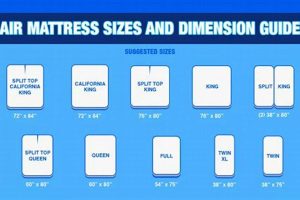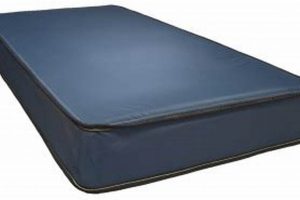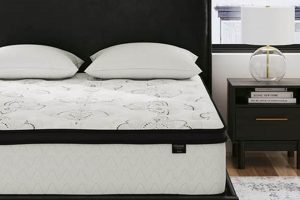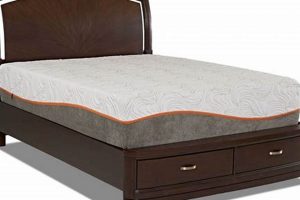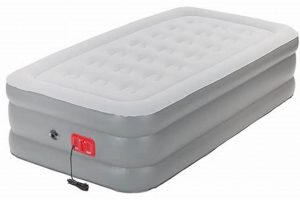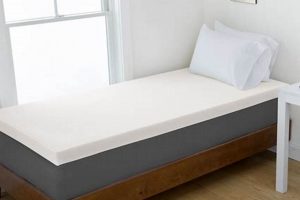A mattress combining both innerspring coils and foam (typically memory foam or latex) in a twin size configuration provides a balance of support and comfort. The coil system offers a traditional bouncy feel and structural stability, while the foam layers contour to the body, alleviating pressure points. This construction aims to deliver a sleeping surface that addresses the individual needs of sleepers who prefer a blend of responsiveness and conforming hug.
This type of mattress offers several advantages. The coil base promotes airflow, helping regulate temperature and prevent overheating during sleep. The foam layers enhance comfort and reduce motion transfer, minimizing disturbances caused by a partner’s movements. Historically, the marriage of coil and foam technologies sought to overcome the limitations of each individual system, resulting in improved sleep quality and durability.
The subsequent sections will delve deeper into the specific components, construction variations, benefits, and considerations associated with choosing such a mattress. Details regarding coil types, foam densities, certifications, and warranty information will also be provided to aid in making an informed purchase decision.
Guidance on Hybrid Twin Mattresses
The following advice is intended to assist in the selection and maintenance of a hybrid twin mattress, optimizing its lifespan and ensuring satisfactory sleep quality.
Tip 1: Evaluate Coil Count and Gauge: A higher coil count typically indicates enhanced support and durability. Similarly, coil gauge (thickness) influences firmness; a lower gauge denotes a firmer mattress.
Tip 2: Examine Foam Density: The density of the foam layers contributes significantly to pressure relief and longevity. Higher density foams generally resist compression and provide better support over time.
Tip 3: Consider Edge Support: Reinforced edges prevent sagging and expand the usable sleep surface. This is particularly relevant for individuals who tend to sleep near the edge of the bed.
Tip 4: Check for Certifications: Certifications such as CertiPUR-US or OEKO-TEX indicate that the foam components have been tested for harmful substances and volatile organic compounds (VOCs), ensuring safer indoor air quality.
Tip 5: Rotate Regularly: Rotating the mattress periodically helps to distribute wear evenly, preventing indentations and extending its lifespan. It is recommended to rotate the mattress every three to six months.
Tip 6: Use a Mattress Protector: A waterproof mattress protector shields against spills, stains, and dust mites, preserving the mattress’s cleanliness and hygiene. This is vital for maintaining warranty validity.
Tip 7: Understand the Warranty: Review the warranty terms carefully, paying attention to coverage limitations and exclusions. Proper maintenance and use are often required to maintain warranty eligibility.
Tip 8: Assess Sleep Position Compatibility: Different sleep positions benefit from varying firmness levels. Side sleepers may prefer a softer mattress to accommodate shoulder and hip pressure, while back and stomach sleepers often require a firmer surface for spinal alignment.
Adhering to these guidelines can significantly enhance the overall experience and longevity of a hybrid twin mattress, ensuring optimal sleep quality and a sound investment.
The subsequent sections will further explore specific aspects of this mattress type, providing additional insights for informed decision-making.
1. Coil System Support in Twin Hybrid Mattresses
Coil system support is a fundamental element in a twin mattress hybrid, providing the foundational structure and contributing significantly to its overall performance. The design and quality of the coil system directly impact spinal alignment, weight distribution, and the longevity of the mattress. Understanding the various facets of coil system support is crucial for selecting a suitable mattress.
- Coil Gauge and Density
Coil gauge refers to the thickness of the individual coils; a lower gauge signifies a thicker, firmer coil. Coil density, or coil count, dictates the number of coils within the mattress core. Higher coil counts generally offer enhanced support and improved conformity to the body’s contours. For instance, a higher gauge coil might be favored in a twin mattress intended for a heavier individual, while a higher coil count can benefit lighter individuals seeking pressure relief.
- Coil Type: Bonnell, Pocketed, and Continuous
Different coil types offer varying degrees of support and motion isolation. Bonnell coils, an older technology, are interconnected, providing uniform support but limited motion isolation. Pocketed coils, individually wrapped, allow for independent movement, minimizing disturbance when one sleeper shifts position. Continuous coils are formed from a single wire, offering durability and consistent support. The choice of coil type influences the overall sleeping experience in a twin mattress hybrid; pocketed coils are often preferred for couples or individuals sensitive to motion.
- Zoned Support Systems
Zoned support systems incorporate varying coil gauges or densities in different areas of the mattress to provide targeted support to specific body regions. For example, the lumbar region may require firmer support to maintain spinal alignment, while the shoulders and hips may benefit from a softer, more conforming surface. In a twin mattress hybrid, zoned support can optimize comfort and pressure relief for individuals with specific needs or preferred sleeping positions.
- Edge Support Reinforcement
Edge support reinforcement strengthens the perimeter of the mattress, preventing sagging and increasing the usable sleep surface. This is particularly important for individuals who tend to sleep near the edge of the bed. Edge support is typically achieved through the use of higher gauge coils, foam encasements, or steel rods. Robust edge support in a twin mattress hybrid enhances stability and prevents the sensation of rolling off the bed.
The interplay between coil gauge, density, coil type, zoned support, and edge reinforcement contributes to the overall effectiveness of the coil system in a twin mattress hybrid. Selecting a mattress with a coil system that aligns with individual preferences and physical needs is essential for achieving optimal sleep quality and long-term comfort.
2. Foam Layer Comfort
The comfort derived from foam layers in a twin mattress hybrid is a critical determinant of overall sleep satisfaction. These layers work in concert with the coil system to provide pressure relief, contouring, and motion isolation. The type,
density, and thickness of the foam significantly influence the feel and performance of the mattress.
- Memory Foam Density and Viscoelasticity
Memory foam’s density, measured in pounds per cubic foot, dictates its support and durability. Higher density foams offer greater resilience and resistance to compression, extending the lifespan of the mattress. Viscoelasticity, the ability of the foam to conform to the body’s shape and slowly return to its original form, contributes to pressure relief by distributing weight evenly. For instance, a higher density memory foam layer in a twin mattress hybrid can alleviate pressure points for side sleepers, promoting better spinal alignment. Lower density foams may be less supportive and more prone to sagging over time.
- Latex Foam: Dunlop vs. Talalay
Latex foam, derived from rubber trees, offers a responsive and resilient alternative to memory foam. Dunlop latex is denser and firmer, providing robust support, while Talalay latex is lighter and more breathable, offering enhanced comfort and pressure relief. The choice between Dunlop and Talalay latex layers in a twin mattress hybrid affects its overall firmness and breathability. Dunlop latex is often used as a supportive base layer, while Talalay latex provides a softer, more cushioning comfort layer.
- Polyurethane Foam Variations
Polyurethane (polyfoam) is a versatile material used in various layers of a twin mattress hybrid. Conventional polyfoam provides basic cushioning, while high-density polyfoam offers greater support and durability. Convoluted or egg-crate polyfoam is often used in comfort layers to enhance airflow and reduce pressure points. The quality and density of polyfoam layers influence the overall comfort and longevity of the mattress. High-density polyfoam is preferable for support layers, while convoluted polyfoam can enhance breathability in the comfort layers.
- Gel-Infused and Open-Cell Foams
Gel-infused foams incorporate gel particles to dissipate heat and regulate temperature, while open-cell foams have a structure that promotes airflow. These technologies mitigate heat retention, a common concern with traditional memory foam. A twin mattress hybrid incorporating gel-infused or open-cell foam layers can provide a cooler and more comfortable sleep environment, particularly for individuals prone to overheating.
The foam layers in a twin mattress hybrid are crucial for delivering comfort, pressure relief, and temperature regulation. By understanding the properties of different foam types and their influence on mattress performance, consumers can make informed decisions to optimize their sleep experience. The combination of supportive coils and conforming foam layers creates a balanced sleep surface that caters to a variety of sleep preferences and needs.
3. Edge Support Stability
Edge support stability is a crucial consideration in a twin mattress hybrid, directly influencing the usable sleep surface, overall structural integrity, and the longevity of the mattress. The design and implementation of edge support systems contribute significantly to the mattress’s ability to maintain its shape and prevent sagging along its perimeter.
- Foam Encasement Design
Foam encasement involves surrounding the coil system with high-density foam, providing a reinforced edge. This design enhances edge support by preventing the coils from compressing excessively near the perimeter. In a twin mattress hybrid, robust foam encasement can translate to a more consistent and supportive sleep surface, minimizing the feeling of rolling off the edge. The density of the foam used in the encasement directly correlates to the level of support offered.
- Reinforced Coil Perimeter
A reinforced coil perimeter utilizes thicker gauge coils or additional coil rows along the edge of the mattress. This strengthens the edge and prevents it from collapsing under pressure. For individuals who frequently sit on the edge of a twin mattress hybrid, a reinforced coil perimeter offers enhanced stability and durability. This feature is particularly beneficial for smaller mattresses where edge usage may be proportionally higher.
- Steel Rod Implementation
Steel rod implementation involves incorporating steel rods along the mattress perimeter to provide rigid edge support. These rods add structural integrity and prevent sagging, ensuring a consistent sleep surface across the entire mattress. Steel rod implementation is a common technique used in higher-end twin mattress hybrids to maximize edge support and extend the mattress’s lifespan. This method often provides the most robust edge support, minimizing compression even under significant weight.
- Impact on Usable Sleep Surface
Adequate edge support stability directly expands the usable sleep surface of a twin mattress hybrid. When the edges are well-supported, sleepers can comfortably utilize the entire mattress without feeling like they are about to roll off. This is especially important for smaller mattresses where every inch of usable space matters. A mattress with weak edge support may effectively function as a smaller sleep surface, diminishing its overall value.
The choice of edge support system significantly influences the performance and longevity of a twin mattress hybrid. A well-designed and implemented edge support system ensures a consistent and stable sleep surface, maximizing comfort and durability. The interplay between foam encasement, reinforced coil perimeters, and steel rod implementation contributes to the overall effectiveness of edge support in these mattress types.
4. Temperature regulation
Temperature regulation within a twin mattress hybrid is a crucial factor influencing sleep comfort and quality. The inherent design, combining both innerspring coils and foam layers, presents a challenge in maintaining a neutral thermal environment. Foam, particularly memory foam, tends to retain heat due to its dense structure and limited airflow. This characteristic can lead to overheating and discomfort, disrupting sleep patterns. Conversely, the innerspring system offers potential for airflow and heat dissipation. The efficacy of temperature regulation in this type of mattress, therefore, relies on carefully selected materials and construction techniques that mitigate heat retention and promote ventilation.
Several strategies are employed to address temperature concerns. Gel-infused memory foam incorporates gel particles designed to absorb and dissipate heat. Open-cell foam structures enhance airflow, allowing heat to escape more readily. The type of coil system also plays a role. Individually pocketed coils facilitate better airflow compared to interconnected coil systems. Latex foam, especially Talalay latex, is known for its breathability and ability to regulate temperature. Mattress manufacturers often combine these features to create a twin mattress hybrid that minimizes heat retention and promotes a cooler sleep surface. For example, a hybrid mattress utilizing pocketed coils, Talalay latex, and gel-infused memory foam can significantly improve temperature regulation compared to a mattress with traditional memory foam and interconnected coils.
Effective temperature regulation in a twin mattress hybrid is esse
ntial for maintaining a comfortable sleep environment and preventing disruptions caused by overheating. The combination of breathable materials, advanced foam technologies, and strategically designed coil systems contributes to a cooler and more restful sleep experience. Understanding the interplay of these factors allows consumers to make informed decisions when selecting a mattress optimized for temperature regulation. Continued innovation in materials and design aims to further enhance the thermal performance of hybrid mattresses, addressing the needs of individuals sensitive to temperature fluctuations during sleep.
5. Motion isolation properties
Motion isolation, a critical attribute in mattresses, dictates the degree to which movement on one area of the sleep surface transfers to other areas. In the context of a twin mattress hybrid, this property is especially relevant, given the smaller surface area compared to larger mattress sizes. Effective motion isolation minimizes disturbances caused by a sleep partner or restless movements during the night.
- Pocketed Coils and Motion Dampening
Pocketed coils, a common component in hybrid mattresses, are individually wrapped springs that operate independently. This design significantly reduces motion transfer compared to interconnected coil systems. When one coil compresses due to weight, the adjacent coils remain largely unaffected, thereby dampening the propagation of movement across the mattress. This is particularly beneficial on a twin mattress, where movements are more likely to be felt across the limited surface area.
- Foam Layer Composition and Vibration Absorption
The type and density of foam layers also influence motion isolation. Memory foam, known for its viscoelastic properties, excels at absorbing vibrations and minimizing their transmission. High-density memory foam, in particular, effectively deadens movement. Latex foam also provides good motion isolation, though it tends to be more responsive than memory foam. The strategic placement of these foam layers within the mattress construction contributes to the overall motion isolation performance.
- Hybrid Construction Synergy and Reduced Disturbance
The combination of pocketed coils and motion-isolating foam layers creates a synergistic effect. The coils provide targeted support and minimize motion transfer at the base, while the foam layers absorb and dampen any residual vibrations. This dual-action approach enhances motion isolation compared to mattresses relying solely on one type of material. The result is a sleep surface that minimizes disturbances, allowing for more restful sleep.
- Impact on Sleep Quality for Light Sleepers
Motion isolation properties are especially crucial for light sleepers or individuals sharing a bed, even if it is occasionally. The ability of a twin mattress hybrid to minimize motion transfer can significantly improve sleep quality by reducing the frequency of awakenings caused by movement. A mattress with poor motion isolation may lead to fragmented sleep and decreased overall restfulness.
The interplay of pocketed coils, motion-dampening foam layers, and the synergistic construction of twin mattress hybrids directly impacts the effectiveness of motion isolation. Selecting a mattress with a focus on these properties can contribute to a more undisturbed and restorative sleep experience, particularly within the constraints of a smaller twin-size mattress.
6. Durability Expectations
Durability expectations for a twin mattress hybrid are critical in evaluating its long-term value and overall cost-effectiveness. The combination of innerspring and foam components introduces unique factors that influence the mattress’s lifespan and sustained performance. Understanding these factors is essential for consumers to make informed purchasing decisions.
- Coil System Fatigue and Longevity
The coil system within a twin mattress hybrid provides foundational support, and its durability is paramount. Factors such as coil gauge, coil type (e.g., pocketed, Bonnell), and the quality of steel used in the coils directly affect the system’s resistance to fatigue and compression over time. Higher gauge coils and more robust steel alloys typically translate to greater durability. Premature coil fatigue can lead to sagging and uneven support, diminishing the mattress’s comfort and orthopedic benefits.
- Foam Density and Compression Resistance
Foam layers, including memory foam, latex, and polyurethane foam, contribute significantly to the comfort and pressure-relieving properties of a twin mattress hybrid. However, these materials are susceptible to compression and degradation over time. Higher density foams generally exhibit greater resistance to compression and maintain their original shape and support characteristics for a longer period. Low-density foams are more prone to permanent indentation and loss of support, reducing the mattress’s lifespan.
- Edge Support Deterioration
Edge support systems, designed to prevent sagging along the perimeter of the mattress, are also subject to wear and tear. Foam encasements can break down over time, losing their structural integrity. Reinforced coil edges may weaken, leading to a collapse of the mattress’s edge. Adequate edge support is vital for maximizing the usable sleep surface and preventing a feeling of rolling off the bed. Deterioration of edge support diminishes both comfort and safety.
- Material Interplay and Overall Mattress Integrity
The interaction between the coil system and foam layers also impacts overall durability. If the coil system fails prematurely, it can place undue stress on the foam layers, accelerating their degradation. Conversely, inadequate support from the foam layers can compromise the integrity of the coil system. The quality of materials and construction techniques used to bond these components together is crucial for ensuring that the mattress maintains its structural integrity and performance characteristics over its expected lifespan.
In summary, durability expectations for a twin mattress hybrid hinge on the quality of its constituent materials, the robustness of its construction, and the interplay between its coil and foam components. Factors such as coil gauge, foam density, edge support design, and overall material integration collectively determine the mattress’s ability to withstand long-term use and provide sustained comfort and support.
Frequently Asked Questions
The following questions and answers address common inquiries regarding twin mattresses integrating both innerspring and foam technologies.
Question 1: What defines a twin mattress hybrid, and how does it differ from other mattress types?
A twin mattress hybrid combines innerspring coils with foam layers (typically memory foam or latex). This construction contrasts with all-foam mattresses, which lack a coil system, and traditional innerspring mattresses, which offer minimal foam layers. The hybrid design seeks to balance support and comfort.
Question 2: What are the primary benefits of a twin mattress hybrid compared to an all-foam or innerspring mattress?
The benefits include enhanced
support from the coil system, pressure relief from the foam layers, improved temperature regulation due to airflow within the coils, and reduced motion transfer. All-foam mattresses may lack adequate support, while innerspring mattresses may offer insufficient pressure relief.
Question 3: How does coil count and coil gauge affect the performance of a twin mattress hybrid?
A higher coil count generally indicates increased support and contouring. Coil gauge, or thickness, influences firmness; a lower gauge number denotes a firmer mattress. The optimal coil count and gauge depend on individual preferences and body weight.
Question 4: What types of foam are commonly used in twin mattress hybrids, and how do their properties differ?
Common foam types include memory foam, latex foam, and polyurethane foam. Memory foam conforms to the body, providing pressure relief. Latex foam offers a responsive feel and breathability. Polyurethane foam serves as a transition or support layer. Their properties influence comfort and durability.
Question 5: How important is edge support in a twin mattress hybrid, and what features indicate good edge support?
Edge support is crucial for maximizing the usable sleep surface and preventing sagging. Look for features such as foam encasement, reinforced coil perimeters, or steel rod implementation to ensure robust edge support.
Question 6: What are the key considerations for maintaining and prolonging the lifespan of a twin mattress hybrid?
Regular rotation, the use of a mattress protector, and adherence to manufacturer guidelines are essential for maintaining a twin mattress hybrid. Avoid excessive weight or pressure on specific areas, and promptly address any spills or stains.
Understanding these aspects can aid in selecting and caring for a twin mattress hybrid effectively.
The following sections provide additional insights into specific features and considerations regarding this mattress type.
Twin Mattress Hybrid
This exploration has systematically examined the twin mattress hybrid, delineating its constituent components, functional attributes, and considerations for optimal selection and maintenance. The convergence of innerspring coil systems and various foam types yields a sleep surface designed to balance support, comfort, and durability. The interplay of coil gauge, foam density, edge support, and temperature regulation ultimately determines the mattress’s overall performance and suitability for individual needs.
Careful consideration of these factors is paramount for discerning consumers. The knowledge presented herein serves to empower informed decision-making, ensuring that a twin mattress hybrid investment aligns with specific requirements for restful and restorative sleep. Further research into emerging materials and technologies within the mattress industry is encouraged, as continued innovation promises to refine the functionality and longevity of this increasingly prevalent sleep solution.


